The deceptively named 'Casuarina Gall' (Cylindrococcus spiniferus)
Deceptive because it doesn't grow on species in the Casuarina genus. Rather Cylindrococcus spiniferus is limited to Allocasuarina species. To add to the confusion galls on Casuarina Glauca can resemble Cylindrococcus galls. These are Cylindrococcus galls https://www.inaturalist.org/taxa/503065-Cylindrococcus-spiniferus/browse_photos?place_id=6744.
Here is an example of a Casuarina glauca gall that looks kind of similar https://www.inaturalist.org/observations/145104003.
It would be reasonable to assume the C. glauca gall was formed by a creature that was at least related to Cylindrococcus, however it seems that they aren't even in the same order. Cylindrococcus is a Felt Scale insect in the family Eriococcidae, in the order Hemiptera.
According to the experts here on Inat the Casuarina glauca galls like the one above are likely to be wasps and in the order Hymenoptera. Or maybe even flies, order Diptera.
See https://www.inaturalist.org/observations/60815964 and https://www.inaturalist.org/observations/55606554
My own misidentification of one of these C. Glauca galls as Cylindrococcus really got me interested: thanks to @penelopeuq for correcting my ID. It is both baffling and intriguing that these seemingly common galls can't be identified, but apparently that's not at all unusual with galls. Perhaps there is more information out there that i can't access as I'm not a scientist. For now I will patiently remain baffled and intrigued.
I wrote a little about this project here:
https://www.inaturalist.org/journal/vavilovian_mimic/73956-casuarina-glauca-galls-project










